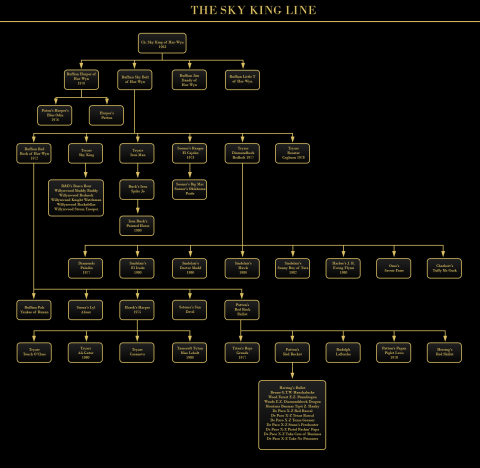Bloodline and strain
Place the cursor on the image below to see an enlargement:
“the concept of "family" includes a group of individuals derived from a couple of common ancestors until the 10th degree of lineage, in other words it means bringing together 5 generations. Then we will talk about bloodline or “bloodstream”, with the lineage of a male reproducer until the fifth generation and still beyond. " - Franco Bonetti
In the field of dog breeding with the term consanguinity we refer to the degree of relatedness which joins directly a dog to its ascendants and descendants. About the concept of relatedness we can say that two dogs with a common ancestor are relatives, that is a pair of common ancestors. There is the direct line (children – parents – grandparents – great-grandparents – great-great-grandparents) that is shown in the pedigree, and the collateral line (brothers-sisters, cousins-cousins, uncles-nephews). A "generation" is the result of every fertilization. Then it is usual to establish the degree of relatedness: in the direct relatedness we have just to count the generations that separate two relatives; in the collateral relatedness, between two dogs, we have to go up from one of these to the common ancestor and then lead to the other one counting the intervening generations. In the selection of pedigree dogs it is important to know what are the dogs from which a litter descends because we will be able to evaluate the characteristics that they passed on to their puppies. The qualities of the dogs that appear in the "bloodstream or bloodline" strengthen themselves when two dogs which have the same ancestors or most of them are mated. A puppy receives the 50% of the genetic material from its father and the 50% from its mother, which in turn received it from their parents, and those from theirs. Why does a litter produce very different dogs? Because in addition to genes, there are many variables that are given by the allomorphic genes that are homologous genes: so they have the same embryonic nature but also a different molecular structure, which causes different events of the same character. By exploiting these features and mating in "consanguinity" (see the chapter Breeding and Selection from "Zanoia's Book of the American Staffordshire Terrier" - 2013 Edizioni Cinque, Biella), or in a more or less close consanguinity, we may fix certain desired features; but remembering that as you fix the qualities, if you are not careful you may fix also the defects. Notice that the concept of "relatedness" is based on the likelihood that two animals having one or more common ancestors have inherited an equal percentage of the "genetic heritage": it means that, as the American geneticist Jay l. Lush affirms, -"the relatedness enhances the resemblance of the individual genotypes, in a greater extent than the average of the population". It is therefore more accurate - according to Mr. Lush – "to consider as consanguinity the mating of animals who are relatives to a greater extent of the average genetic relatedness existing in the population or in the breed. All this takes place normally in nature with the natural selection in animals that live in packs, like wolves, where the genetic heritage that is transmitted is the one of the animals that have the characteristics of shape, strength, intelligence, skills, health more suited to survival. Through the breeding and the artificial selection of the "Bulls and Terriers" men intervened in the reproduction to maintain and develop the features that best allowed him to obtain that utility purposes he was looking for, consequently the livestock selection of “The Grand Old Breed” has given rise to - the dog breed now recognized as the American Staffordshire Terrier – the birth and the records of the Bloodlines descended from the Ancient Dog Strains recognized by the American Kennel Club. The bloodline and the perfect knowledge of its development is what allows the best breeders to obtain extraordinary results in the selection of the purebred dog.

